There are great walking experiences to be found across the Falkland Islands. The capital, Stanley, has a beautiful coastline with stunning white sand beaches, rocky shores and a variety of heath and scrubland. Nearby Cape Pembroke is a lovely area with small ponds, coves and a charming lighthouse.
Explore further afield around the East, West and offshore islands. Coastlines vary from rugged coastal cliffs to long miles of undisturbed sands, interspersed with rocky headlands and large kelp forests. Mount Usborne on East Falkland is the highest peak at 705 metres (2,312 feet) and provides an excellent spot for a day walk, boasting a spectacular panorama from the plateau and exhilarating scrambles through the stone runs.
Whether you stumble across a hidden cove, an undiscovered sheep track or an area of natural beauty totally unspoilt by human activity, walking the Falkland Islands is a truly unforgettable experience.
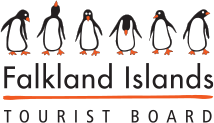
Moody Brook and Sapper’s Hill
For those who like to get their hiking boots on and fancy more of a walk, Moody Brook at the west end of Stanley Harbour is an excellent choice. Located about two miles from the centre of town, while there isn’t a mass of abundant wildlife or historic sites along the route, it makes for a pleasant stroll on a sunny day.
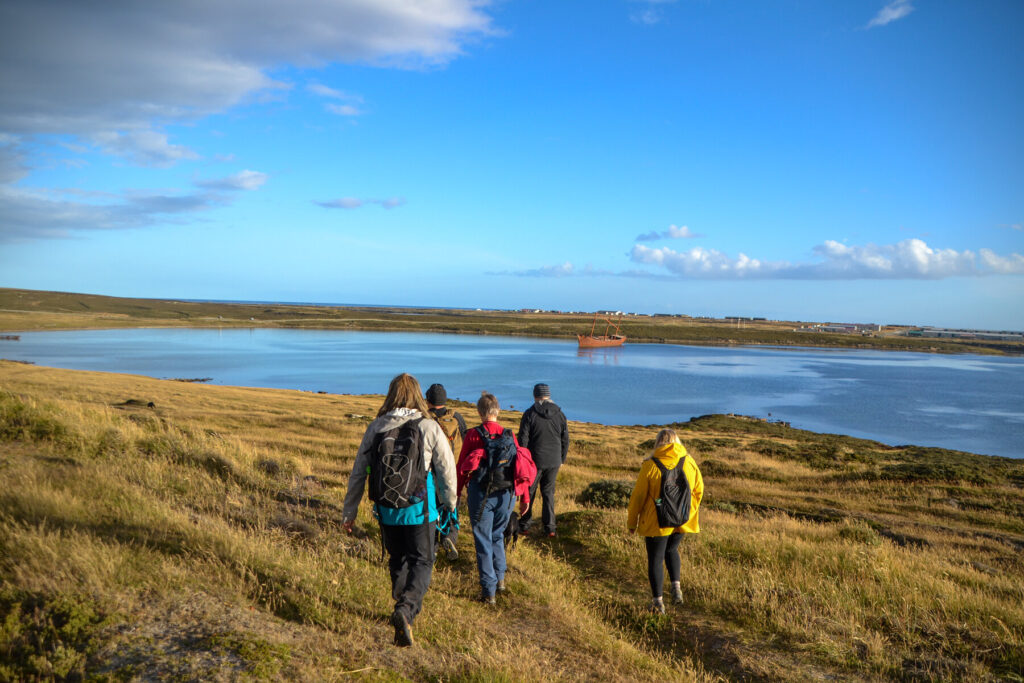
Another superb view over Stanley can be had from Sapper’s Hill, which overlooks the town from the west. From here you can see Stanley laid out before you, over the harbour to Port William, and out over the South Atlantic Ocean to the south. This viewpoint is reached by heading west towards Government House from the Historic Dockyard Museum, but turning south down Darwin Road, following it to the Stanley–Mount Pleasant Airport Road for half a mile and then turning on to the track that leads up the hill for a few hundred yards.
Volunteer Point
Volunteer Point is named after the Volunteer, a ship that visited the Falkland Islands in 1815. This privately owned nature reserve is on a narrow strip of short grass that connects East Falkland to the headland of Volunteer Point itself and is a popular choice among walking enthusiasts.
The wardens’ house is at the western end of the grassy area, while the king penguin colony is at the eastern end. This colony is one of the highlights of any visit to the Falkland Islands – it is the largest colony of this species on the islands and is still increasing. As you near the site on the tracks from Johnson’s Harbour, the whole area opens up spectacularly before you, revealing the lagoon, penguins and beach.
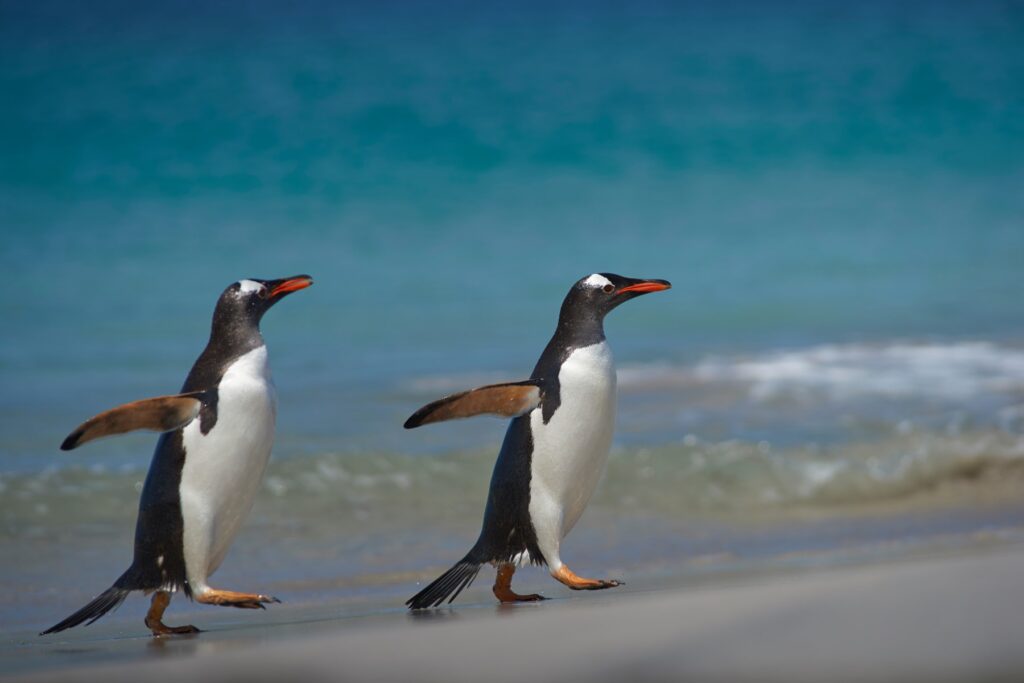
A walk beyond the eastern fence for half a mile or so leads visitors out on to a series of headlands, some with spectacular caves. Rock shags breed on some of the headlands and night herons can often be found feeding in the pools. This walk gives another dimension to this already fascinating area as it is slightly higher and you can look back along the whole of Volunteer Beach.
Darwin and Goose Green
Darwin and Goose Green are situated less than a mile apart on the narrow neck of land that joins the two sections of East Falkland: the low-lying land of Lafonia to the south and Wickham Heights and the Onion Range to the north. There are a number of walking opportunities here, designed to suit all levels of fitness and expertise. You can wander around the shores of Darwin Harbour, or, for the energetic, arrange a lift to the base of Mount Usborne and climb the highest peak on the islands.
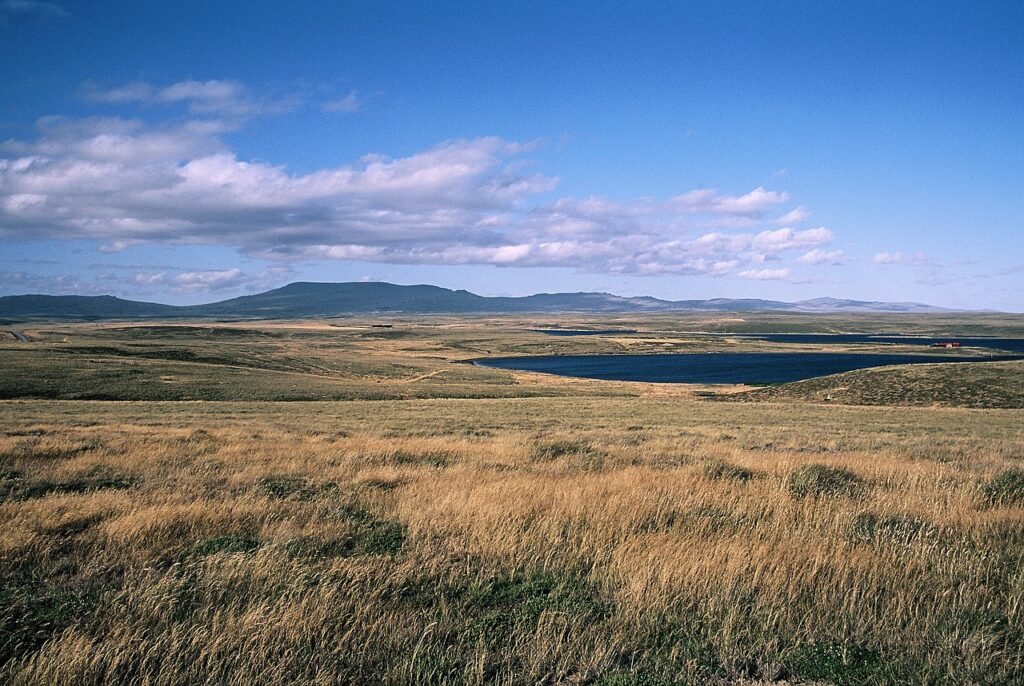
The road from Darwin towards Goose Green cuts through the Boca Wall, only a 5-minute walk from the lodge. This gorse-covered bank of peat marks the division between the two settlements and was built in 1849. A little further along the road is Darwin Hill where there is a memorial to the 17 men of the second parachute regiment who died in action. Spend an afternoon strolling and you’ll learn experience as much history as you do natural beauty.
Sea Lion Island
This small island offers a wide variety of walks, although there are no marked paths or signs to follow. It is possible to walk around the whole coast in one day; however, this would mean missing many of the spectacular sights that make this island so unique. A minimum stay of two nights is recommended, but to enable you to revisit favourite spots, three would be a better idea.
Cow Point, North East Point and Elephant Corner
It is possible to explore the eastern end of the island before lunch. The closest beach, Cow Bay, can be reached by cutting across the field to the north of the lodge and continuing down a shallow valley through the tussac grass towards the sand. Many magellanic penguins nest in this area, including one pair often seen using a burrow almost under one of the old stiles.
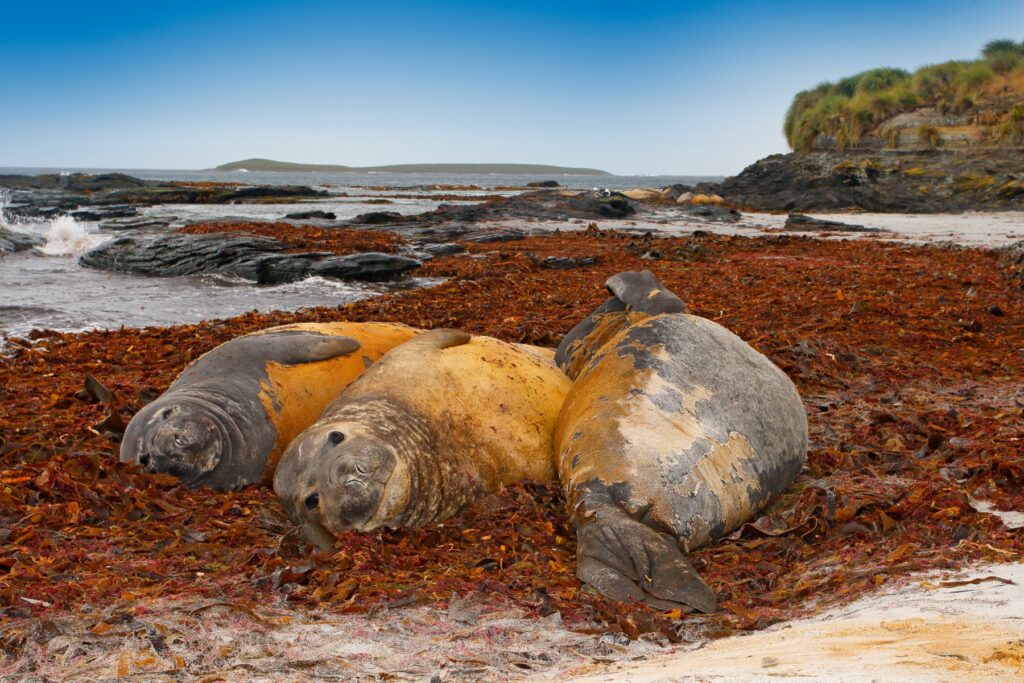
Turning around and heading east, one can walk along the sand towards Cow Point. This area has many small birds, including Cobb’s wrens, popping in and out of the stones at your feet, while elegant dark-faced ground-tyrant catch flies at the top of the beach. From Cow Point, small numbers of gentoo penguins can be seen porpoising their way back to the shore through the banks of offshore kelp.
Located nearby is a small bay, aptly named Elephant Corner. Here, visitors can push through the tussac grass on the path of least resistance in order to reach a low promontory in the middle of the cove. The elephant seals can be viewed in safety from here and it is an excellent spot for photography.
Port Howard
Staying at Port Howard gives you the opportunity to explore the area around the lodge. A gentle stroll along the main tracks takes in the sites and the settlement’s birdlife, but with a little more time you can walk further to Bull Cove or southwards along Port Howard Harbour.
Another walk takes you northeast from the lodge, along the main road to Fox Bay and the rest of West Falkland. After 100yds, before the newer farm sheds, leave the road and bear right for another 200yds as the track you’re now following rises up towards the airstrip overlooking the settlement. Walk up over the airstrip and along the inlet on the far side of it and, after another 600yds or so, you will reach a small headland and the cemetery where the grave of Captain Hamilton, who lost his life during the Argentinian occupation in 1982, can be found.
Saunders Island – The Neck
The Neck, one of the Falklands’ best wildlife sites, offers many enjoyable walking opportunities. Elephant seals can be found at Elephant Point, the furthest point on the island from the settlement. There are some small pools just inland from Elephant Point which have harboured a variety of wildfowl, including the odd scarce species coming in from South America, such as white-winged coot and rosy-billed pochard.
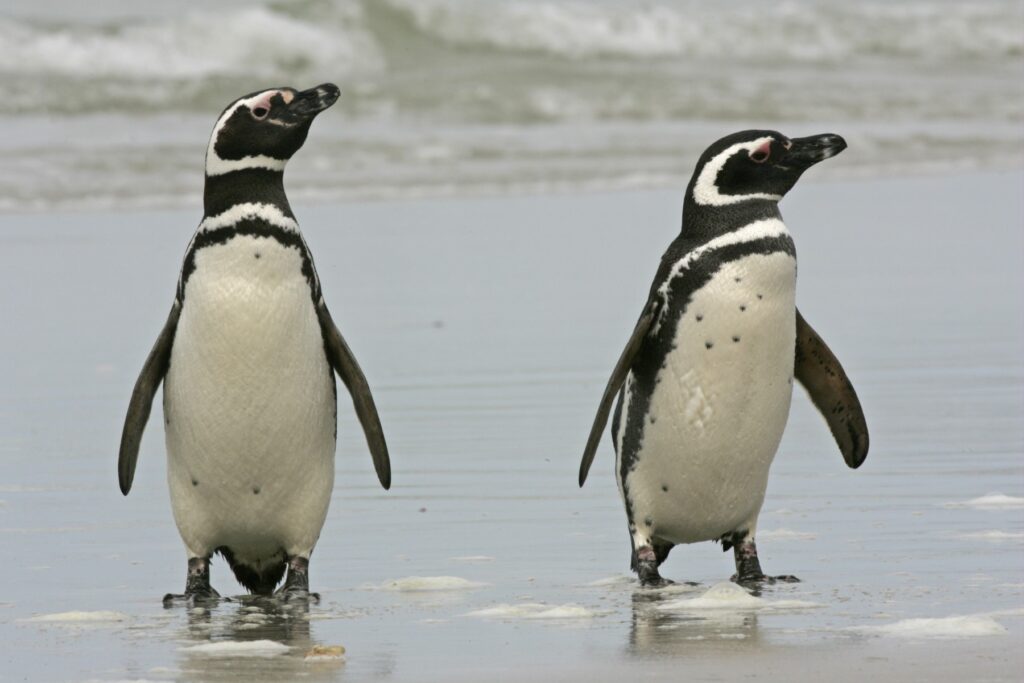
For those wanting to head uphill, the view from the top of Mount Harston (433m) looks back down to The Neck. On a clear day you can see across to Carcass Island and West Point Island and over to the Jasons away on the northwest horizon. The Neck is less than a mile away from the hill, and although the walk is steep, with no clear route to follow, it’s not especially difficult.
Weddell Island
Weddell Island, comprising some 63,000 acres, is the third-largest island of the Falklands. As there are no footpaths on the island you can walk wherever your fancy takes you but, for a nice 2-hour stroll, head east around the northern side of Gull Harbour from the settlement and follow the shore for a while before continuing out to Mark Point, which juts out into Queen Charlotte Bay. This is a good spot to look for whales in late summer – both southern right and sei whales have been seen from here.
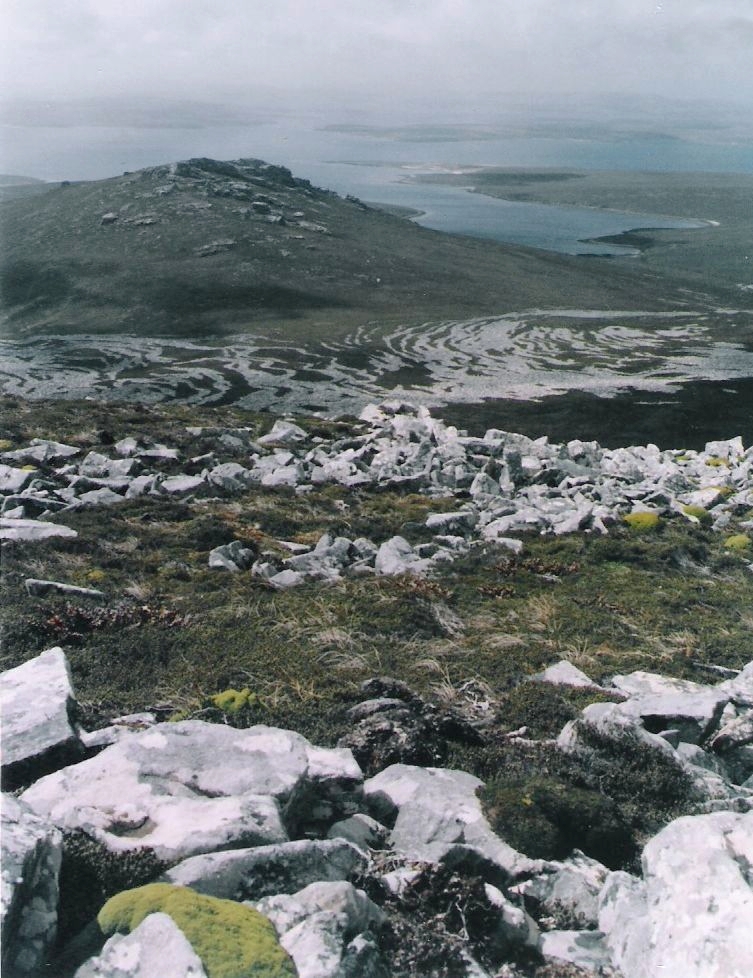
Another good walk, taking potentially a full day, heads north away from the settlement towards Loop Head. The southern sea lion colony at the far end of this headland is about eight miles away. However, the headland is narrow enough that those looking for a shorter walk can cut across from one side to the other at any point to loop back. At about five miles out there is an especially narrow section where the headland is only yards wide. The far end of Loop Head, looking out into Queen Charlotte Bay, provides a nice vantage point from which to watch the whales during mid to late summer.
More information
To learn more about the Falkland Islands, visit the Falkland Islands Tourist Board website or check out Will Wagstaff’s guide: